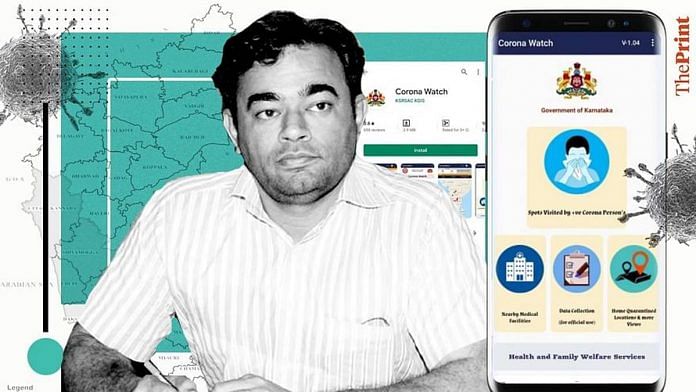
Bengaluru: Apps to help health workers follow up with Covid patients, trace contacts, and monitor those in home isolation. Software to track vaccine supply, monitor medical oxygen production and supply, triage Covid-positive people, allot beds to those in need, and facilitate a callback system. And systems to connect on-ground frontline staff, the war room and laboratories uploading test results — Karnataka’s efforts to manage the pandemic are technology driven.
Two years into the pandemic, the system — with various teams consisting of bureaucrats, medical and paramedical students, ASHA workers, doctors and tech-savvy youngsters — has won much recognition. On the war room’s behalf, its chief, IAS officer Munish Moudgil, received the Union government’s e-governance Jury Award for the use of information and communications technology (ICT) in pandemic management in January this year.
“Many apps that we used during the first two waves, or their functions, have been integrated to more advanced platforms, but we continue to rely on technology for efficient Covid-19 management,” Moudgil told The Print.
“We have StepOne for Home Isolation, Index and Line Listing for patient management, a contract tracing app — a technology unique to Karnataka — etc. We have internal software that connects the war room with frontline workers on the ground to reach out to citizens. We also have software that keeps track of patient data, monitors health, and arranges call enquiries, triaging, and bed allotment,” he added.
Private medical practitioners and health experts say that Karnataka led the way in adopting technological solutions for healthcare.
“Karnataka was quick to adopt technology into healthcare management, creating a hyperloop of sorts. We have always looked at Bengaluru as the Silicon Valley of India, and the speed and efficiency with which we came up with medtech solutions proved that point,” Dr Vishal Rao, Dean, Centre for Academic Research, HCG Cancer Centre, Bengaluru, and member of the Karnataka Covid taskforce’s Genomic Surveillance Committee, told ThePrint.
“The biggest takeaway was Karnataka’s progression into M-tech (mobile technology) from tele-tech (telephone consultation). This allowed not only monitoring of Covid-19 patients but also other medical issues that were being ignored due to the pandemic,” he added.
Also read: This is how Karnataka’s Covid War Room is fighting the big battle, one app at a time
How does the system work?
When a person undergoes a Covid-19 test, the data is marked on the Government of India app. Test results are uploaded to the Indian Council of Medical Research (ICMR) portal via a Union government network. The Karnataka state war room downloads this data on an hourly basis — and this is where the state’s technology-driven pandemic management begins.
“We access the list of positive patients from ICMR and this is sent to local war rooms at the district level, and parallelly to frontline workers on the ground in each ward via the Contact Tracing app. They approach the patient to collect details of their contacts and upload this to the Quarantine Watch app, which is shared with the home isolation monitoring team,” said Moudgil.
“The data is used for triaging, teleconsultation, physical contact etc. Once triaged, medical teams visit patients who require hospitalisation, assess what kind of beds they need and update it to an app. This is used by the bed allotment system to block specific types of beds at hospitals. The status of the patient is constantly updated. Those in home isolation are monitored using StepOne,” he added.
At around 8 pm every day, Moudgil’s team of about 40 war room staff put together detailed daily analysis of the Covid-19 situation and trends in the state. The analysis provides a look into comparative seven-day averages, and region-wise, district-wise, gender-wise, and age-wise comparison of Covid data.
“We have leveraged the presence of a large number of healthcare resources — nurses, resident doctors, and medical students, including those doing Unani and Ayurveda courses. They are entrusted with triaging calls,” Pankaj Kumar Pandey, in-charge, home isolation, told The Print.
Pandey added that using technology to track patients, with interactive voice response (IVR) calls to monitor health status, has lessened the burden on human resources.
Given the state’s experiences in the second wave last year, when patients struggled to get hospital beds, the state government has set up an elaborate system for triaging. The process allows experts to categorise patients as those needing hospitalisation (most vulnerable, co-morbid), Covid care centres (moderate patients) or home isolation.
Around 10,000 students have been trained for triaging. “This time, almost 95 per cent of patients are in home isolation. That, and the triaging system, have ensured that our healthcare facility isn’t stressed,” added Pandey.
First come the automated calls or messages on receiving test results, then triaging by medical students or nurses, and then teleconsultation with doctors and specialists if need be.
“On day four, there is a physical call to check on the patient, and on day seven a ‘discharge call’. We place IVR calls on all the other days. We have an app allowing doctors to write a prescription and send it to patients and follow up on their health conditions. StepOne is a not-for-profit initiative by private entities as part of their CSR (corporate social responsibility) activity,” Pandey said.
Karnataka has also been using software to update daily oxygen requirements and demand.
(Edited by Rohan Manoj)
Also read: Time to move past test-track-treat as Omicron officially at community transmission, say experts

COMMENTS